Occlusal Radiographs Important Notes
- Lateral oblique projections

Occlusal radiograph long essay questions
Occlusal Radiographs Long Essays
Question 1. What are the indications for occlusal radiographs? Describe radiographic technique in taking maxillary and mandibular cross sectional occlusal radiograph.
Or
What are the indications for occlusal radiographs? Describe radiographic technique in taking maxillary and mandibular topographic occlusal radiograph.
Answer.
occlusal radiograph Indications:
- To locate retained roots of extracted teeth
- To locate supernumerary, unerupted or impacted teeth
- To locate foreign bodies in the jaw
- To locate salivary stones in ducts of submandibular gland
- To locate and evaluate the extend of the lesion
- To evaluate boundaries of the maxillary sinus
- To evaluate fractures of the maxilla and mandible
- To aid in examination in patient with trismus
- To examine area of cleft palate
- To measure changes in the size and shape of the maxilla and mandible
- For determining the bucco/palatal position of unerupted canines
Maxillary Cross Sectional View:
- Image Field:
- It shows palate
- Zygomatic process of the maxilla
- Anterior inferior aspects of each antrum
- Nasolacrimal canals
- Teeth from right second molar to left second molar
- Nasal septum
- Film Placement:
- The film is placed crosswise into the mouth and gently pushed back until it contacts the anterior border of the rami
- Projection of the Central Ray:
- Angulation:
- Vertical: +6°
- Horizontal: 0°
- Entry of central ray through the bridge of the nose
- Angulation:
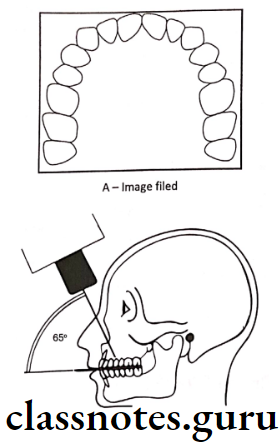
Read And Learn More: Oral Radiology Question and Answers
Mandibular Cross Sectional View:
- Image Field:
- It shows
- Soft tissues of the floor of the mouth
- Delineates the lingual and Buccal plates of the jaw bone
- Teeth from second molar to second molar
- Film Placement:
- The film is placed in the mouth with its long axis perpendicular to the sagittal plane
- The pebbled surface is towards the mandible
- The anterior border of the film should be approxiamately 1/2 inch anterior to the Mandibular central incisors
- Projection of the Central Ray:
- It is directed at right angles to the center of the film
- Point of entry:
- Middle through the floor of the mouth
- Approximately 3 cm below the chin
- Point of entry:

Types of occlusal radiographs explained
Question 1. Indications and technique for occlusal radiograph for topographical view.
Answer.
Indications and technique for occlusal radiograph for topographical view
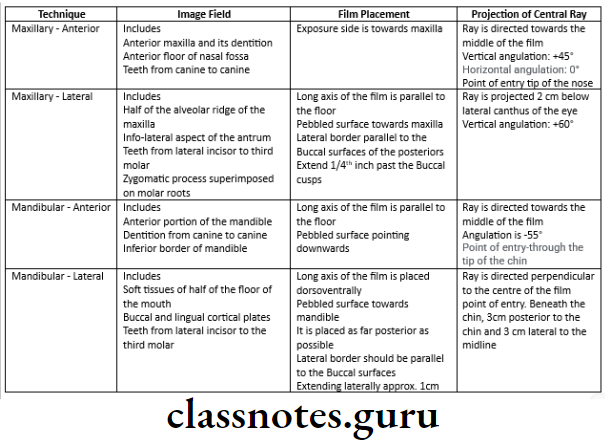
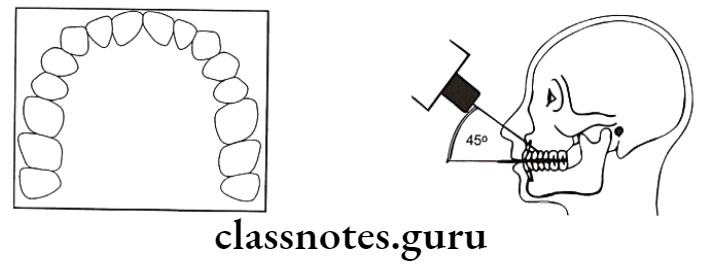

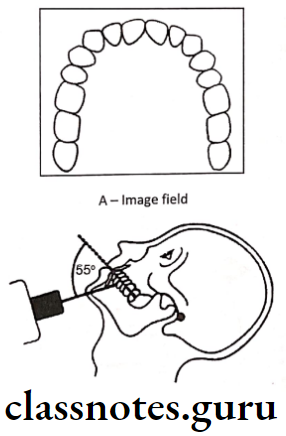
Maxillary and mandibular occlusal radiographs
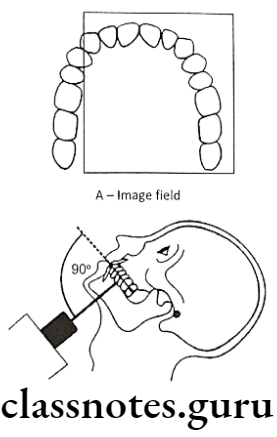
Occlusal radiograph Basic Principles:
- Film is positioned with white side facing the arch being exposed
- Film is placed in the mouth between the occlusal surfaces of the maxillary and Mandibular teeth
- The film is stabilized when the patient gently bites on the surface of the film
- For maxillary occlusal films the patient’s head is positioned such that upper arch is parallel to the floor
- Mid sagittal plane should be perpendicular to the floor
- For Mandibular radiograph the patient’s head is retroclined such that the lower arch is perpendicular to the floor
Occlusal radiograph Film Used:
- Occlusal film is used
- Its dimensions are:
- 57 x 76 mm
